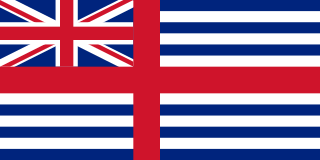
Van Diemen's Land was the colonial name of the island of Tasmania used by the British during the European exploration and colonisation of Australia in the 19th century. The island, inhabited by Aborigines, was first encountered by the Dutch ship captained by Abel Tasman in 1642, working under the sponsorship of Anthony van Diemen, the Governor-General of the Dutch East Indies. The British retained the name when they established a settlement in 1803 before it became a separate colony in 1825. Its penal colonies became notorious destinations for the transportation of convicts due to the harsh environment, isolation and reputation for being inescapable.

The Macquarie Harbour Penal Station, a former British colonial penal settlement, established on Sarah Island, Macquarie Harbour, in the former Penal colony of Van Diemen's Land, now Tasmania, operated between 1822 and 1833. The settlement housed male convicts, with a small number of women housed on a nearby island. During its 11 years of operation, the penal colony achieved a reputation as one of the harshest penal settlements in the Australian colonies. The former penal station is located on the eight-hectare (twenty-acre) Sarah Island that now operates as a historic site under the direction of the Tasmania Parks and Wildlife Service.
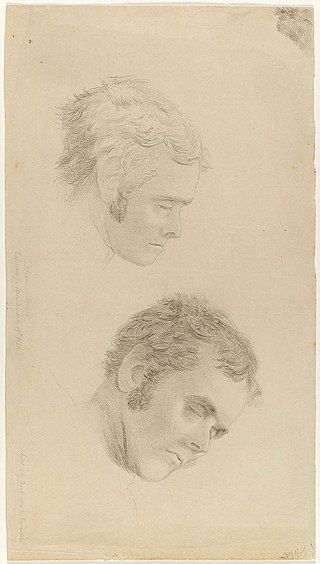
Alexander Pearce was an Irish convict who was transported to the penal colony in Van Diemen's Land, Australia for seven years for theft. He escaped from prison several times, allegedly becoming a cannibal during two of the escapes. He was eventually captured and was hanged in Hobart for murder, before being dissected.

The West Coast of Tasmania has a significant convict heritage. The use of the west coast as an outpost to house convicts in isolated penal settlements occurred in the eras 1822–33, and 1846–47.
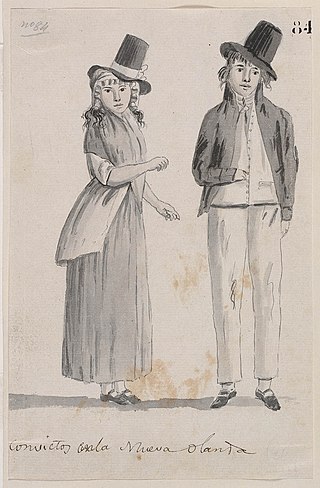
Between 1788 and 1868 the British penal system transported about 162,000 convicts from Great Britain and Ireland to various penal colonies in Australia.
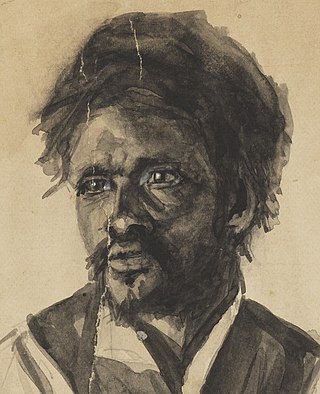
Musquito was an Indigenous Australian resistance leader, convict hunter and outlaw based firstly in the Sydney region of the British colony of New South Wales and, after a period in exile on Norfolk Island, in Van Diemen's Land.
HMCS Integrity was a cutter built by the Colonial Government of New South Wales in 1804. She was the first vessel ever launched from a New South Wales dockyard and carried goods between the colony's coastal settlements of Norfolk Island, Newcastle, New South Wales, Van Diemen's Land and Port Jackson. In 1804 she took part in a series of voyages to Van Diemen's Land with the aim of founding a colony at Port Dalrymple, the site of the modern settlement of George Town, Tasmania.
Charlotte Badger was a former convict who was on board the Venus during a mutiny in Tasmania in 1806. Taken to New Zealand, she was rescued by Captain Turnbull of the Indispensable, and eventually she returned to Sydney. In the intervening centuries, a number of writers have contributed to the fiction that she took an active role in the mutiny and she became known – erroneously – as Australia's first female pirate.
Andrew Bent was a printer, publisher and newspaper proprietor, active in Australia. He established the first successful newspaper in Tasmania, was the first Australian newspaperman to print a newspaper free from government control, and the first Australian printer to be imprisoned for libel.
Asia was a 410-ton merchant brig built at Shields in 1817. During her career she made one voyage for the British East India Company (EIC), and one transporting convicts from England to Van Diemen's Land. She is last listed in 1833 and may have wrecked late that year.
Andromeda was built in Sunderland, England in 1819. Initially she made one voyage to India, sailing under a licence from the British East India Company. She then started sailing to Australia, carrying voluntary and involuntary migrants. She made four voyages transporting convicts: one voyage to Van Diemen's Land and three to New South Wales. She continue to trade, primarily to Australia. Her last voyage was to Ichaboe Island. She was last listed in 1847.
Henry Saxelby Melville Wintle, commonly referred to as Henry Melville, was an Australian journalist, author, occultist, and Freemason best remembered for writing the play The Bushrangers, his historical work The History of Van Diemen's Land From the Year 1824 to 1835, and his occult philosophical work Veritas: Revelation of Mysteries, Biblical, Historical, and Social by Means of the Median and Persian Laws. His life was dramatized in the 1882 Princess Theatre (Bendigo) production Found, or Found Drowned.

The Cyprus mutiny took place on 14 August 1829 in Recherche Bay off the British penal settlement of Van Diemen's Land. Convicts seized the brig Cyprus and sailed her to Canton, China, where they scuttled her and claimed to be castaways from another vessel. On the way, Cyprus visited Japan during the height of the period of severe Japanese restrictions on the entry of foreigners, the first ship from Australia to do so.
The Frederick escape was an 1834 incident in which the brig Frederick was hijacked by ten Australian convicts and used to abscond to Chile, where they lived freely for two years. Four of the convicts were later recaptured and returned to Australia, where they escaped the death sentence for piracy through a legal technicality.

Cyprus was a brig launched at Sunderland in 1816. The colonial government in Van Diemen's Land purchased her in 1826. In 1829 as she was transporting convicts from Hobart Town to Macquarie Harbour Penal Station, some of the convicts seized Cyprus. They sailed her via Japan to Canton, where they scuttled her.
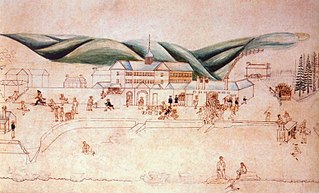
The Cooking Pot Uprising or Cooking Pot Riot was an uprising of convicts led by William Westwood in the penal colony of Norfolk Island, Australia. It occurred on 1 July 1846 in response to the confiscation of convicts' cooking vessels under the orders of the Commandant of the penal settlement, Major Joseph Childs.
Norfolk Island twice served as a penal colony, from March 1788 to February 1814, and from 1825 to 1853. During both periods the government in the Colony of New South Wales transferred convicts that had been brought to Australia on to the island.
Tiger was launched in America in 1813 and apparently captured on her maiden voyage. Captain Lewellyn purchased her in prize and initially she sailed between England and the Mediterranean. Under new ownership in the early-1820s, she started trading with New South Wales and India under a license from the British East India Company (EIC). She is last listed in 1833.
HM Colonial brig Prince Leopold was launched in 1815, or earlier, as Rosetta. The government in Van Diemen's Land (VDL) purchased her in 1818 to serve the settlements. She then carried timber other supplies, and transferred both prisoners and soldiers between VDL and Port Jackson, and to and from Maria Island. In July 1831 the government sold the brig. Her new owners named her Mary Elizabeth, or Mary and Elizabeth. She was wrecked on 30 May 1835 at Port Sorell, Tasmania.
Captain Duncan Mackellar, was a sea captain who later became a colonial settler in New South Wales, Australia. After a notable maritime career, including a daring escape from French capture in 1812, he visited Sydney in 1822 and decided to settle there. By 1829, he and his nephew, Duncan Mackellar, Junior, acquired substantial land near Braidwood.









